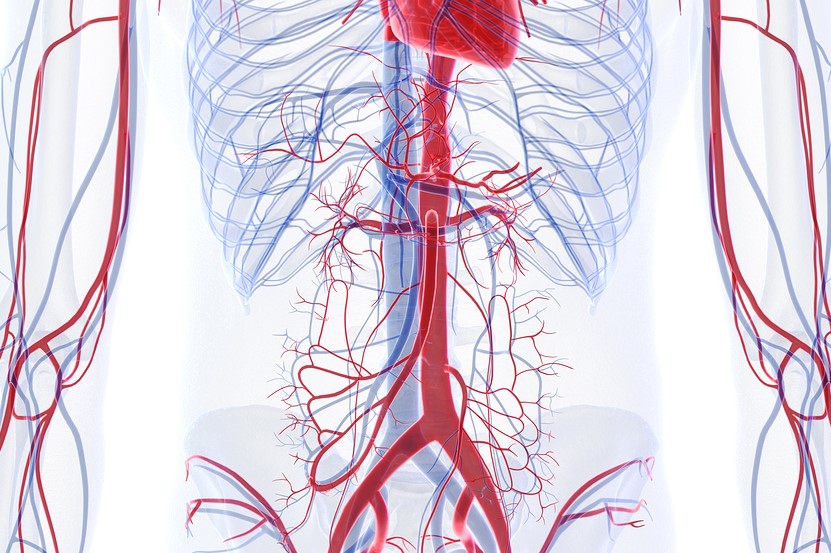
Abdominal aortic aneurysm: epidemiology and diagnosis
Abdominal Aortic Aneurysm is a circumscribed dilatation of the aorta running through the abdomen, basically a widening of the artery beyond its caliber limits
The abdominal Aorta normally has a caliber that does not exceed 2-2.5 cm in diameter.
When it exceeds these limits we speak, up to 3 cm of Ectasia of the Aorta, from 3 cm and above of Abdominal Aortic Aneurysm (AAA).
Epidemiology: which categories are most affected by abdominal aortic aneurysm?
Abdominal Aortic Aneurysm affects 4% of men and 1% of women after the age of 60-65 years, according to current statistics.
In practice, for every 1,000 men over the age of 60, there are certainly 40 men in the population with aortic aneurysm, and for every 1,000 women over the age of 60, there are certainly an equal number of 10 women suffering from it.
We also know that some categories of people are more at risk than others: for example, diabetics, the obese, the hypertensive, the hypercholesterolemic, smokers, and those who lead sedentary lives.
Most of these 40 men and 10 women out of every 1,000 people over the age of 60 do not know they have an abdominal aortic aneurysm
The aneurysm, in fact, before it reaches a crucial point in size, is absolutely asymptomatic, that is, it gives no sign of itself.
Where it does, on the other hand, it can be the cause of major complications; but also because of its progressive and inevitable evolution, it is known that aneurysm leads, sooner or later, to rupture of the artery, a rupture that suddenly becomes a dramatic emergency, often the cause of death.
This is the reason why it is necessary to act on the prevention of the fatal complications of aneurysm, especially since the examinations are absolutely simple, free of harmful side effects, and accessible to all.
Information also plays a key role.
In the United Kingdom, for example, there is commendable public awareness that “Screening for aortic aneurysms in men over the age of 60-65 is beneficial in terms of reducing mortality.”
(US Preventive Services Task Force. Screening for abdominal aortic aneurysm: recommendation statement. Ann Intern Med 2005;142:198-202).
Prevention
Prevention consists of recognizing the presence or onset of Aortic Aneurysm in a person in time, diagnosing it, specifying its location (e.g., whether supra- or subrenal), and monitoring it periodically to follow its natural evolution.
Periodic checks are essential to avoid any complications and intervene surgically where there is a possibility of a rupture, thrombosis, dissection, or periaortic hematoma.
With careful and periodic ultrasound monitoring, it is possible to prevent the time of the most serious complication, aortic aneurysm rupture, with the risk of imminent death that it brings.
The most appropriate tool for recognizing (or ruling out) an aortic aneurysm and following its evolution is ultrasound with echocolordoppler
Computerized Axial Tomography (CT) or Magnetic Resonance Imaging (MRI) are also suitable, and sometimes necessary, but they are much less practical and manageable than ultrasound; moreover, they are impractical for screening or periodic monitoring, both because of the high cost and long waiting lists, but especially because of the contraindications and/or exposure to ionizing radiation that they inevitably (at least for CT) entail.
Abdominal aortic aneurysm, when is surgery necessary?
When dimensions greater than 5 cm in axial scanning are reached, it is necessary to refer the subject to a good vascular surgeon for surgery and thus calmly plan the best operative act to surgically resolve the serious pathology.
In this way, healthy condition and normal circulation in the body’s largest artery can be restored and life expectancy can be greatly increased.
Read Also:
Emergency Live Even More…Live: Download The New Free App Of Your Newspaper For IOS And Android
Extrasystole: From Diagnosis To Therapy
The Quick And Dirty Guide To Cor Pulmonale
Ectopia Cordis: Types, Classification, Causes, Associated Malformations, Prognosis
Temporal And Spatial Disorientation: What It Means And What Pathologies It Is Associated With
Abdominal Aortic Aneurysm: What It Looks Like And How To Treat It
Cerebral Aneurysm: What It Is And How To Treat It
Ruptured Aneurysms: What They Are, How To Treat Them
Pre-Hospital Ultrasound Assessment In Emergencies
Unruptured Brain Aneurysms: How To Diagnose Them, How To Treat Them
Ruptured Brain Aneurysm, Violent Headache Among The Most Frequent Symptoms
Concussion: What It Is, Causes And Symptoms
Ventricular Aneurysm: How To Recognise It?
Arrhythmias: The Alterations Of The Heart
Tachycardia: Is There A Risk Of Arrhythmia? What Differences Exist Between The Two?
Pathologies Of The Left Ventricle: Dilated Cardiomyopathy
Arrhythmogenic Cardiomyopathy: What It Is And What It Entails
Atrial Fibrillation: Symptoms To Watch Out For
Wolff-Parkinson-White Syndrome: What It Is And How To Treat It
Do You Have Episodes Of Sudden Tachycardia? You May Suffer From Wolff-Parkinson-White Syndrome (WPW)
Transient Tachypnoea Of The Newborn: Overview Of Neonatal Wet Lung Syndrome
Myocardial Infarction: Causes, Symptoms And Risk Factors
Dilated Cardiomyopathy: What It Is, What Causes It And How It Is Treated
Heart Disease: What Is Cardiomyopathy?
Inflammations Of The Heart: Myocarditis, Infective Endocarditis And Pericarditis
Heart Murmurs: What It Is And When To Be Concerned
Broken Heart Syndrome Is On The Rise: We Know Takotsubo Cardiomyopathy
Cardiomyopathies: What They Are And What Are The Treatments
Alcoholic And Arrhythmogenic Right Ventricular Cardiomyopathy
Difference Between Spontaneous, Electrical And Pharmacological Cardioversion
Heart Failure: Symptoms And Possible Treatments
What Is Heart Failure And How Can It Be Recognised?
Heart: What Is A Heart Attack And How Do We Intervene?
Heart Attack Symptoms: What To Do In An Emergency, The Role Of CPR
Bradyarrhythmias: What They Are, How To Diagnose Them And How To Treat Them
Paediatric Arrhythmias: What They Are, How To Treat Them


